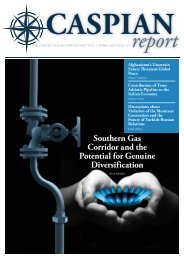You also want an ePaper? Increase the reach of your titles
YUMPU automatically turns print PDFs into web optimized ePapers that Google loves.
Figure 12. Electricity generation by fuel type<br />
Source: DG Energy (<strong>2014</strong>). EU Energy, Transport and GHG Emissions, Trends to 2050<br />
4. DISCUSSION AND<br />
CONCLUSIONS<br />
In this paper, we have provided a<br />
brief overview of EU energy markets.<br />
Historically, EU countries have been<br />
dependent on imported fossil fuels.<br />
However, the Council of the European<br />
Union has launched ambitious<br />
energy policies to ensure energy security<br />
and reduce GHG emissions. To<br />
achieve these goals, several legally<br />
binding regulations aimed at increasing<br />
energy efficiency and the share of<br />
clean and renewable energy sources<br />
have already been enacted. But even<br />
if these policies achieve their desired<br />
targets, the EU will still depend on<br />
fossil fuels to meet the energy needs<br />
of the growing economies. In fact, it<br />
is anticipated that fossil fuels will still<br />
provide 63% of the EU’s total energy<br />
consumption by 2050. Oil and coal<br />
will become less important, while<br />
reliance on renewable sources will<br />
increase significantly. Nuclear energy<br />
and natural gas will maintain their<br />
current shares in total energy use.<br />
Market prices (excluding taxes) of<br />
crude oil, refined oil products and<br />
coal were almost the same in the EU<br />
countries, as these products are easily<br />
traded across countries. The prices<br />
of natural gas and electricity, on the<br />
other hand, have been divergent, especially<br />
in countries that are less integrated<br />
with other markets. One of<br />
the priorities of the European energy<br />
policies is to create a single market<br />
for these energy products. 3 Historically,<br />
domestic electricity and gas<br />
markets have usually been highly monopolistic.<br />
Therefore, by integrating<br />
and further liberalising markets, the<br />
EU aims to increase competition in<br />
the markets and thus improve energy<br />
efficiency. It is expected that effective<br />
unbundling (separation of networks<br />
from activities of production and supply)<br />
will ensure secure operation of<br />
the networks and create incentives to<br />
invest adequately in the energy network.<br />
Energy transmission networks<br />
are characterised by high investment<br />
expenditures. However, once the required<br />
interconnections and tie-ins<br />
53<br />
CASPIAN REPORT, FALL <strong>2014</strong><br />
3.<br />
See, for example, Directives 2009/72/EC and 2009/73/EC.










